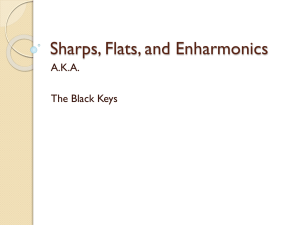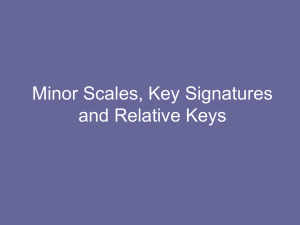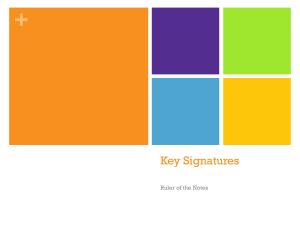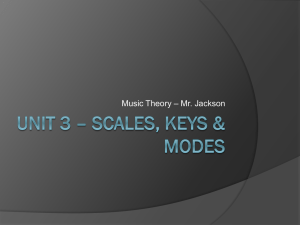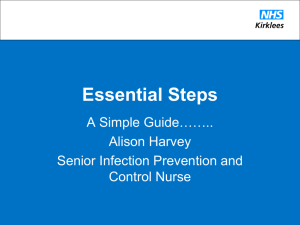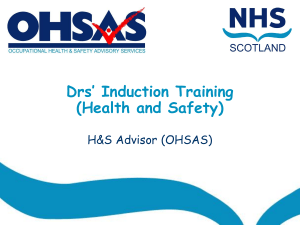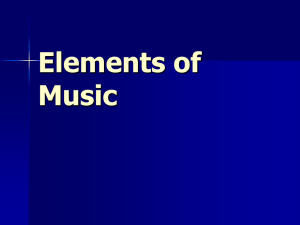Grade 9 Instrumental Music Theory Workbook
advertisement
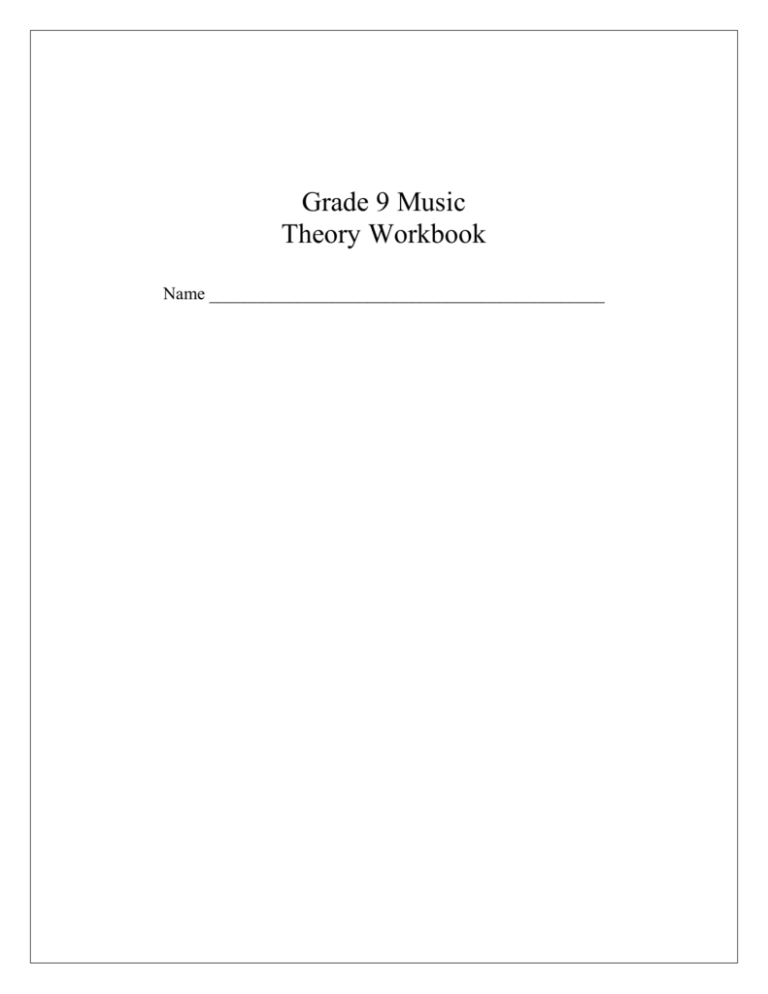
Grade 9 Music Theory Workbook Name _____________________________________________ Grade 9 Theory Activity 1 – Note Naming *I am responsible for knowing all the notes in the treble and bass clefs, including ledger lines. 1. Identify all notes on this grand staff (Use capital letters only). 2. Name these notes. 3. Name these notes. 4. Place these notes on the treble clef. Make 2 of them on ledger lines. A G C F E B 5. Place these notes on the bass clef. Make 2 of them on ledger lines. G C D A B F Grade 9 Theory Activity 2 – Flats and Sharps * I am responsible for knowing flats, sharps and naturals and how they function in music. 1. Definitions: Sharp: __________________________________________________________________ Flat: ___________________________________________________________________ Natural: _________________________________________________________________ 2. Draw at least 8 flats in the stave below. Place each one on a different line or space. 3. Draw at least 8 sharps in the stave below. Place each one on a different line or space. 4. Name these notes: 5. Place these notes on the treble clef. Make 2 of them on ledger lines. C# Eb Db Ab F# G# 6. Place these notes on the bass clef. Make 2 of them on ledger lines. Ab G# Eb Bb A# D# Key Signatures The key signature (group of flats or sharps at the beginning of a piece of music) tells us which notes are to be raised or lowered throughout the piece. Name all of the notes in the examples below. Accidentals Sharps, flats and naturals can be used within a piece of music to alter the pitch of a note. The rule is that the pitch remains altered throughout the entire bar. With this rule in mind, name all of the notes in the following example. Grade 9 Theory Activity 3 – Symbols and Rests * I am responsible for recognizing the musical symbols we have used in performance and knowing their function. Music Symbols Staff Sign used for repeat Treble Clef The end Bass Clef Coda Mark Bar Line Tie (as in D.S.) Double Bar Fine Slur Measure Fermata (hold) Sharp Tenuto ten. -or- Flat Breath mark ’ Natural Accent Repeat Da Capo Sforzando D.C. (from the beginning) Notes and Rests Staccato sfz. a) Identify the following symbols: a) _________________ b) ______________________ c) ____________________ d) ____________________ e) f) _______________ ’ __________ g) ___________________ h) sfz ___________________ b) Give the function for each: a) D.C. ___________________________________________________ b) ___________________________________________________ c) ___________________________________________________ d) ___________________________________________________ e) ___________________________________________________ f) ___________________________________________________ Composition Write an 8 bar composition in the space below using the following criteria: a) Make sure each bar has the correct number of beats b) Use half notes, quarter notes and eighth notes c) Use at least two accidentals (This may include natural signs) (Use the first two lines for your rough work. Your final work will appear on the last two lines.) Grade 9 Theory Activity 4 – Italian Terms * I am responsible for knowing all the Italian terms we have used in performance. TEMPO adagio andante moderato allegro presto very slow moderately slow moderate fast very fast accelerando ritardando a tempo gradually getting faster gradually getting slower return to the original tempo pianissimo piano mezzo piano mezzo forte forte fortissimo crescendo decrescendo gradually getting louder gradually getting softer DYNAMICS pp p mp mf f ff ARTICULATION legato staccato smoothly, gliding detached OTHER coda Da Capo fine poco molto tutti solo soli 1. Write all five tempo indications in order from slowest to fastest: ______________ 2. closing section from the beginning the end a little a lot all one player one section or group ______________ ______________ _____ _____ _____ _____ ____________________ c) fine ____________________ ____________________ d) pp ____________________ b) accelerando ____________________ Identify the following: a) mf b) tutti 4. ______________ Write all six dynamic indications in order from softest to loudest: _____ 3. ______________ Give the function for the following: a) Da Capo ____________________ Grade 9 Theory Activity 5 – Note Values * I am responsible for knowing all note values from the whole note to the sixteenth note. Pie Picture Note Name Note Value 1. Write one note equal to the following: a) = ______________ f) = ______________ g) = ______________ h) = ______________ = ______________ b) = ______________ c) = ______________ d) e) = ______________ 2. Write two notes of equal value: a) = ____ + ____ d) b) = ____ + ____ = ____ + ____ e) c) = ____ + ____ = ____ + ____ f) = ____ + ____ 3. Each bar must have four beats. Complete each bar using only one symbol. a) b) c) A dot placed beside a note increases its value by 50%. 4. How many beats is each of the following dotted notes worth? a) b) = ____ beats c) = ____ beats d) = ____ beats = ____ beats 5. Give one note equal to the following. Each answer is a dotted note. a) = ____ b) = ____ c) = ____ d) = ____ Grade 9 Theory Activity 6 – Metre * I am responsible for knowing about the organization of time into units, called metre. The two numbers at the beginning of a piece of music are very important, as they indicate how time is organized throughout the music. Units called bars or measures each have the same number of beats. 1. Complete the following: 2 means that there are ______ ____________________ notes in each bar. 4 3 means that there are ______ ____________________ notes in each bar. 4 4 means that there are ______ ____________________ notes in each bar. 4 5 means that there are ______ ____________________ notes in each bar. 4 2 means that there are ______ ____________________ notes in each bar. 2 6 means that there are ______ ____________________ notes in each bar. 8 2. Place the correct time signature on each example: a) b) c) 3. Complete each bar using only one note. a) b) c) 4. Write a rhythmic composition in time using quarter notes, eighth notes and at least one dotted note. Please remember to fill in the time signature. 5. Write a rhythmic composition in time using eighth notes, sixteenth notes, eighth rests and syncopation. Please remember to fill in the time signature. 6. Write a rhythmic composition in time using eighth notes, sixteenth notes, eighth rests and syncopation. Please remember to fill in the time signature. Grade 9 Theory Activity 7 – Rests * I am responsible for all rests, from the whole rest to the sixteenth rest. Number of beats Note Rest Whole 4 beats Half 2 beats Quarter 1 beat Eighth ½ beat Sixteenth ¼ beat 1. Answer the following with one rest: a) = _____ b) = _____ 2. Complete these bars using only one rest. a) b) c) = _____ d) = _____ Grade 9 Theory Activity 8 – Families of Instruments * I am responsible for knowing the families of instruments in the concert band. Place the following instruments into the categories below: trombone, snare drum, flute, bass clarinet, alto saxophone, triangle, tenor saxophone, trumpet, baritone saxophone, tuba, bass drum, crash cymbals, xylophone, marimba, bells, clarinet, French horn, piccolo, bassoon, oboe Woodwind Concert Pitch Pitched Percussion Non-Pitched Percussion Brass Bb Instruments Percussion Eb Instruments Grade 9 Theory Activity 9 – Semitones and the Chromatic Scale * I am responsible for knowing the chromatic scale A chromatic scale contains every possible note between two notes an octave apart. There are 12 different notes in a chromatic scale, each one a semitone away from the next. A chromatic scale consists entirely of semitones. When going up the chromatic scale, we use the sharp names. When going down the chromatic scale, we use the flat names. Semitone: The smallest possible distance between two notes. Label the piano keyboard below with both the sharp names and flat names. 1. Which 2 pairs of white notes are a semitone apart? _____ and _____ _____ and _____ 2. Give the note that is a semitone above each of the following: a) F _____ d) Ab _____ b) B _____ e) D _____ c) _____ f) G _____ F# 3. Give the note that is a semitone below each of the following: a) F _____ d) Ab _____ b) B _____ e) D _____ c) _____ f) G _____ F# 4. Count semitones to find the note that is: a) 2 semitones above C _____ b) 3 semitones above F _____ c) 2 semitones below Bb _____ d) 4 semitones above G _____ e) 6 semitones above E _____ f) 8 semitones below F# _____ g) 2 semitones above D _____ h) 3 semitones below C _____ 5. Write an ascending chromatic scale starting and ending on C. Please remember to fill in the clef – you may choose either treble or bass. 6. Write a descending chromatic scale starting and ending on C. Please remember to fill in the clef – you may choose either treble or bass. 7. In each bar, write the note that is a semitone higher than the one given. 8. In each bar, write the note that is a semitone lower than the one given. Grade 9 Theory Activity 10 – Tones and Semitones * I am responsible for knowing the definitions of semitones and tones, and being able to recognize and write them on the stave. DEFINITIONS Semitone ________________________________________________________________________ ______________________________________________________________________________________ Tone ________________________________________________________________________ 1. Name the note that is a semitone above each of the following: a) F ____ d) Eb ____ b) B ____ e) C Ab ____ f) Bb ____ c) ____ 2. Name the note that is a tone above each of the following: a) F ____ d) Eb ____ b) B ____ e) C Ab ____ f) Bb ____ c) 3. Circle only the pairs of notes that are a semitone apart: 4. Circle only the pairs of notes that are a tone apart: ____ 5. Write a note which is a semitone above each of the following: 6. Write a note which is a tone above each of the following: 7. Write a note that is a semitone below each of the following: 8. Write a note that is a tone below each of the following: 9. Write a scale beginning on C which consists entirely of whole tones. Stop when you reach the octave. How many notes are there in a whole tone scale? _________________ Grade 9 Theory Activity 11 – The Major Scale * I am responsible for knowing how to construct a Major Scale beginning on any note. Examine the pattern of tones and semitones in the scale below: The formula (pattern of tones and semitones) for the Major Scale is ____ ____ ____ ____ ____ ____ ____ 1. On the scales below, add the necessary flats or sharps to make a Major Scales: 2. Write major scales starting on the following notes. Please fill in a clef. Eb Ab Grade 9 Theory Activity 12 – Key Signatures * I am responsible for knowing all Major Scales and their key signatures. Sharp Keys Practice writing all 7 sharps in their correct order: FCGDAEB Write each scale using the formula T T S T T T S. Then place the correct key signature at the beginning of the stave. G Major – 1 Sharp D Major – 2 Sharps A Major – 3 Sharps E Major – 4 Sharps B Major – 5 Sharps F# Major – 6 Sharps C# Major – 7 Sharps Flat Keys Practice writing all 7 flats in their correct order: BEADGCF (notice that this is the exact reverse of the order of sharps) F Major – 1 Flat Bb Major – 2 Flats Eb Major – 3 Flats Ab Major – 4 Flats Db Major – 5 Flats Gb Major – 6 Flats Cb Major – 7 Flats Complete the chart below, referring to the scales above: no. of sharps or flats 0 1 2 3 4 5 6 7 Sharp Keys Flat Keys Grade 9 Theory Activity 13 – Key Signatures 2 * I am responsible for being able to write Major Scales in two ways – with accidentals or with key signatures. The order of sharps is _____ _____ _____ _____ _____ _____ _____ The order of flats is _____ _____ _____ _____ _____ _____ _____ The relationship of the order of sharps to the order of flats is _____________________________________ On the stave below, write all 7 sharps (in their correct order), and all 7 flats (in their correct order). Write the Major Scales indicated below, using accidentals. Be sure to use the formula for a Major Scale: D Major Eb Major Write the following major scales using key signatures. Be sure to refer to your chart. E Major Ab Major Grade 9 Theory Activity 14 – Intervals Within the Major Scale Definition: An interval is the distance between two pitches. When we stay within the Major Scale, and the lower note is the tonic, all intervals are Major or Perfect. PU M2 M3 P4 P5 M6 M7 P8 Write the intervals indicated in the key of F+ PU M2 M3 P4 P5 M6 M7 P8 Write a note above the one given to form the intervals indicated. P5 M2 M3 P4 P4 M3 M2 M7 M2 M6 P5 M6 P5 P8 M3 M7 PU M3 Auditory Memory – We can associate beginning of familiar songs with these intervals. Write the names of the songs that will help you to remember each of the diatonic intervals. a) M2 ________________________ e) M6 ________________________ b) M3 ________________________ f) M7 ________________________ c) g) P8 ________________________ P4 ________________________ d) P5 ________________________ Grade 9 Theory Activity 15 – Music Careers Due Friday May 30th Please submit electronically to mcconveyk@hdsb.ca Research 5 careers that involve music. Give a brief description of each career. For example: Career – Recording Engineer Recording engineers are responsible for operating all electronic and recording equipment in a recording studio. The way a recording or sound engineer sets up and uses this equipment will have a large impact on the final product. The terms “sound technician”, “audio technician”, “sound mixer”, or “sound engineer” are often used to describe this career, but these tend to be less descriptive with regards to the actual job requirements. Many schools offer degree or diploma programs in recording/audio engineering. One example is the Trebas Institute in Montreal, which offers a 1 year Audio Engineering program. The salary range for this career is quite wide, depending largely on factors such as experience, location, and clientele. Expect to earn anywhere between ~$25 000 (no experience) and ~$75 000 (an experienced and well-connected engineer) Marking Scheme Each career is out of 5, for a total of 25 marks. The following things will contribute to the 5 marks: - Quality of description - Reference to required education - A general salary range Response Guidelines and Exemplars Listening Response Guidelines - What do you like about the piece we listened to? Be musically descriptive and specific. - What do you not like about the piece we listened to? Be musically descriptive and specific. Example Response 1 This piece made me think of a Disney fairy tale. It sounded really magical and happy because of the forte dynamic, fast tempo and major key. The staccato notes made it sound light, but it also sounded really thick and heavy because of how many instruments there were, and how at times they would begin with one instrument, build on it and then launch into forte. The trumpets also made it sound full. The second section felt melancholy because of the legato style and much slower tempo. This section was also quieter. Example Response 2 I like the tempo changes as they provide a contrast of mood. I also liked the consonance of the piece. It was pleasing to the ear and remained constant throughout. The rests in the piece provide dramatic pauses, and this contributes to the laziness of the song. It is almost as if you are waiting in anticipation for more to happen. I find the lack of diversity of instruments uninteresting. I tend to like music with many instruments because of the harmony and contrast created by their interaction. I also didn’t like the mood of the song. It was a fairly relaxed mood. The only parts of the song I really liked were when the tempo seemed to get faster, causing the mood to escalate to one that was happier. Self Critique Guidelines - What mark do you think you earned on this test? (This isn’t necessarily the grade you will receive, but it is a good starting point for self-critique.) - Why did you give yourself this mark? (What did you do well? What did you not do well?) - What will you do differently to prepare for the next playing test? (Or, if you don't want to do anything differently, what did you do to prepare for this one that led to success?) Example Response 1 I think that the mark I should receive on this test is 16/20. I think I should receive this mark because although I was uneven on many of the rhythms and didn’t hold many of the long notes for their full value, all of the notes were correct and I didn’t really speed up or slow down during any sections. Next time I will practice playing the long notes for more than what they are worth so that when I play in front of than audience and shorten the notes I will actually be playing the note for its regular value. What I really need to work on is practicing in front of an audience. I will play in front of my family and friends as much as possible to help me with my nerves.
